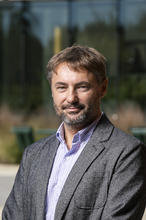In This Story
Researchers in the College of Health and Human Services and College of Computing and Engineering seek to develop a new, quantitative approach to analyzing the age of bruises
Researchers in Mason's College of Health and Human Services and Volgenau School of Engineering received a $988,559 grant from the U.S. Department of Justice, Office of Justice Programs, for a three-year study pairing forensic bruise analysis with machine learning.

School of Nursing Associate Professor Katherine Scafide, Director of the Machine Learning and Inference Laboratory Janusz Wojtusiak, and Associate Professor in the Department of Civil, Environmental, and Infrastructure Engineering David Lattanzi are continuing their work on forensic bruise analysis on diverse skin tones with this new grant.
Law enforcement and legal professionals often rely on the accuracy and interpretation of injury documentation to inform their decisions; however, current bruise assessments provide little reliable data that can be used.
“Image analysis using deep learning, a sub-domain of machine learning, has demonstrated significant benefits in accuracy and reliability within health care; yet few studies have applied these techniques to the forensic analysis of injuries,” said Scafide, the principal investigator. “Our new study seeks to use deep learning to help improve our understanding of how bruises appear over time on diverse skin tones. The results will have broad implications for forensic clinical practice, criminal justice response, and future research.”

The team will develop a new, quantitative approach to identify the age of a bruise using deep learning models while determining its reliability and accuracy. Additionally, the team will develop a secure, searchable platform to store digital bruise images providing a comprehensive look at the healing process across diverse skin tones. The platform will integrate deep learning modeling and support future research and collaboration within the forensic science community.
“There is great potential for machine learning to support and improve forensic nursing techniques and reporting. Machine learning helps solve complex problems, and in forensic nursing, it can aid in the understanding of bruise tones over time,” said Wojtusiak.
Lattanzi brings his expertise using deep machine learning and image analysis to track damage to civil infrastructure to the research team. "It's exciting to take what we've learned and apply it in a way that deepens the societal impact of our work," said Lattanzi.

This research directly builds off a 2019 Summer Impact Grant that the research team received from the Mason Provost Office.
“This new grant from the Justice Department exemplifies how we were able to turn a multidisciplinary and collaborative research-learning experience for undergraduates into a federally-funded and impactful research project that can benefit the health and well-being of vulnerable populations,” said Scafide.
"This collaboration started because a former doctoral student of mine met Kat and recognized that she and I might have a promising collaboration," said Lattanzi. "This project really speaks to the critical role graduate students play in advancing research by making connections that faculty don't always see."
##
